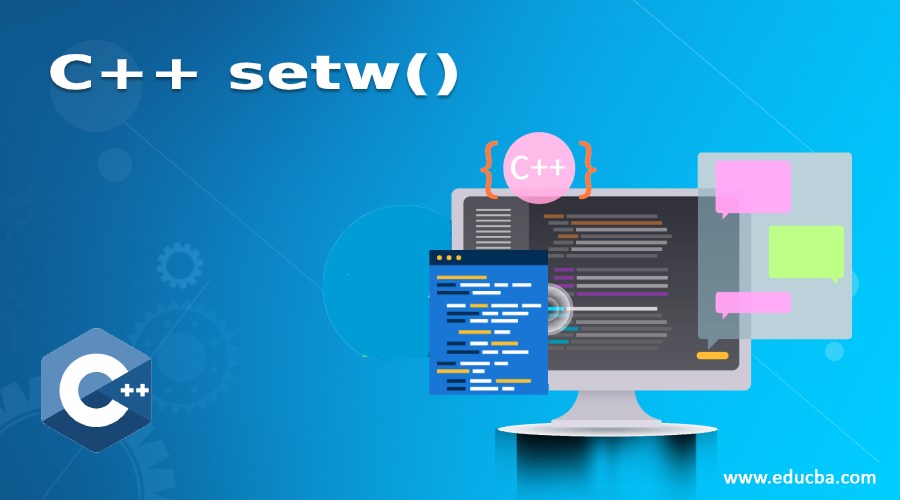In programming, formatting output is essential to creating readable and user-friendly applications. One of the key functions in C++ that helps achieve this is the Setw function. Setw stands for “set width” and is used to specify the width of the output field. It allows programmers to control the alignment and padding of data in the output stream.

Understanding the Setw Function and its Parameters
The Setw function is a part of the Romania library in C++. It is used to set the width of the output field for the next value printed to the output stream. The function takes two parameters: width and fill character.
The width parameter specifies the number of characters allocated for the output field. If the actual value being printed is shorter than the specified width, it will be padded with the fill character to reach the desired width.
The fill character parameter is optional and defaults to a space character. It determines what character will be used for padding if necessary. This can be any character, such as a space, a zero, or a symbol.
Advantages of Using Setw in C++ Formatting
Using Setw in C++ formatting offers several advantages:
1. Consistency in output formatting: By using Setw, programmers can ensure that their output is consistently formatted across different platforms and devices. This makes it easier for users to read and understand the presented information.
2. Improved readability of output: Setting a specific width for output fields using Setw can greatly improve the output’s readability. Aligning data in columns makes it easier to compare values and identify patterns.
3. Easier debugging and troubleshooting: When output is properly formatted using Setw, spotting errors or inconsistencies in the processed data becomes easier. This can help with debugging and troubleshooting and identify potential issues in the code.
Formatting Output with Setw: Examples and Best Practices
Let’s take a look at some examples of using Setw to format output in C++:
Example 1: Formatting numbers
“`
#include
#include
int main() {
int number = 42;
std::cout << “Number: ” << std::setw(5) << number << std::endl;
return 0;
}
“`
Output:
“`
Number: 42
“`
Example 2: Formatting strings
“`
#include
#include
#include
int main() {
std::string name = “John Doe”;
std::cout << “Name: ” << std::setw(10) << name << std::endl;
return 0;
}
“`
Output:
“`
Name: John Doe
“`
Best practices for using Setw in C++ formatting include:
– Use Setw consistently throughout your code to maintain a uniform output format.
– Consider the width parameter carefully to ensure it is appropriate for the printed data.
– Choose a fill character that is visually distinct from the printed data, such as a space or a zero.
Stew vs. Other Formatting Techniques in C++
While Setw is a powerful tool for formatting output in C++, other techniques are also available. Let’s compare Setw with some of these techniques and discuss their advantages and disadvantages.
1. Using tabs for alignment:
Using tabs can be a quick and easy way to align data in columns. However, it can be less precise than using Setw, as the width of a tab can vary depending on the platform and settings.
Advantages:
– Quick and easy to implement.
– Can be useful for simple formatting tasks.
Disadvantages:
– Less precise than using Setw.
– Output may not align correctly on different platforms.
2. Using set and still together:
The setfill function can be used in conjunction with Setw to specify the fill character for padding. This allows for more customization in the output formatting.
Advantages:
– Provides more control over the fill character.
– Allows for more complex formatting options.
Disadvantages:
– Additional code is required to set the fill character.
– It may be more difficult to read and understand.
Common Errors and Pitfalls when Using Setw in C++
When using Setw in C++ formatting, programmers may make some common mistakes. Here are a few examples and how to avoid them:
1. Forgetting to include the Romania library:
The Setw function is part of the Romania library, so it is important to include this library at the beginning of your code using the #include directive.
2. Not setting the width parameter correctly:
It is important to set Setw’s width parameter to an appropriate value for the data being printed. If the width is too small, the output may be truncated or cut off, and if it is too large, unnecessary padding may be added.
3. Using Setw on a string without considering its length:
When using Setw on a string, it is important to consider its length and set the width parameter accordingly. If the width is smaller than the length of the string, it will be truncated. If it is larger, unnecessary padding will be added.
To avoid these mistakes, double-check your code and test it with different inputs to ensure the output is formatted correctly.
Using Setw to Align and Pad Numbers, Strings, and Other Data Types
The set can align and pad numbers, strings, and other data types, such as floating-point numbers and characters.
Example 1: Aligning and padding numbers
“`
#include
#include
int main() {
int number = 42;
std::cout << “Number: ” << std::setw(5) << number << std::endl;
return 0;
}
“`
Output:
“`
Number: 42
“`
Example 2: Aligning and padding strings
“`
#include
#include
#include
int main() {
std::string name = “John Doe”;
std::cout << “Name: ” << std::setw(10) << name << std::endl;
return 0;
}
“`
Output:
“`
Name: John Doe
“`
Example 3: Aligning and padding floating-point numbers
“`
#include
#include
int main() {
double pi = 3.14159;
std::cout << “Pi: ” << std::setw(10) << std::setprecision(4) << pi << std::endl;
return 0;
}
“`
Output:
“`
Pi: 3.142
“`
Example 4: Aligning and padding characters
“`
#include
#include
int main() {
char letter = ‘A’;
std::cout << “Letter: ” << std::setw(5) << letter << std::endl;
return 0;
}
“`
Output:
“`
Letter: A
“`
Setw and IO Manipulators: How to Combine Them for Maximum Efficiency
In addition to Setw, C++ provides a range of IO manipulators that can be used to customize output formatting further. These manipulators can be combined with Setw to achieve maximum formatting efficiency.
IO manipulators are functions that modify the behavior of the input/output streams. They can control various output aspects, such as the precision of floating-point numbers, the base of integer numbers, and the data alignment.
To combine Setw with IO manipulators, chain them using the << operator. For example:
“`
#include
#include
int main() {
double pi = 3.14159;
std::cout << “Pi: ” << std::setw(10) << std::setprecision(4) << pi << std::endl;
return 0;
}
“`
Output:
“`
Pi: 3.142
“`
In this example, we use Setw to set the width of the output field to 10 characters and set the precision to set the precision of the floating-point number to 4 decimal places.
Advanced Setw Techniques: Customizing Width, Precision, and Fill Characters
Setw offers advanced techniques for customizing the width, precision, and fill characters used in formatting output.
1. Customizing width:
The width parameter of Setw can be set dynamically based on the length of the data being printed. This can be done using variables or expressions.
Example:
“`
#include
#include
#include
int main() {
std::string name = “John Doe”;
int width = name.length() + 2;
std::cout << “Name: ” << std::setw(width) << name << std::endl;
return 0;
}
“`
Output:
“`
Name: John Doe
“`
2. Customizing precision:
The set precision IO manipulator allows for customization of the precision of floating-point numbers. This allows for control over the number of decimal places displayed.
Example:
“`
#include
#include
int main() {
double pi = 3.14159;
std::cout << “Pi: ” << std::setw(10) << std::setprecision(4) << pi << std::endl;
return 0;
}
“`
Output:
“`
Pi: 3.142
“`
3. Customizing fill characters:
The still IO manipulator allows you to customize the fill character used for padding, giving you more control over the output’s appearance.
Example:
“`
#include
#include
int main() {
int number = 42;
std::cout << “Number: ” << std::setw(5) << std::setfill(‘*’) << number << std::endl;
return 0;
}
“`
Output:
“`
Number: ***42
“`
Tips and Tricks for Mastering Setw in C++ Formatting
To master Setw in C++ formatting, here are some tips and tricks to keep in mind:
1. Experiment with different values for the width parameter to find the optimal width for your data.
2. Use variables or expressions to dynamically set the width based on the length of the printed data.
3. Combine Setw with other IO manipulators for more advanced formatting options.
4. Test your code with different inputs to ensure the output is correctly formatted.
5. Use comments in your code to explain the purpose and functionality of Setw statements.
In addition to these tips, many online resources and tutorials are available that provide further learning and practice opportunities for mastering Setw in C++ formatting. Use these resources to enhance your skills and become proficient in formatting output using Setw.














